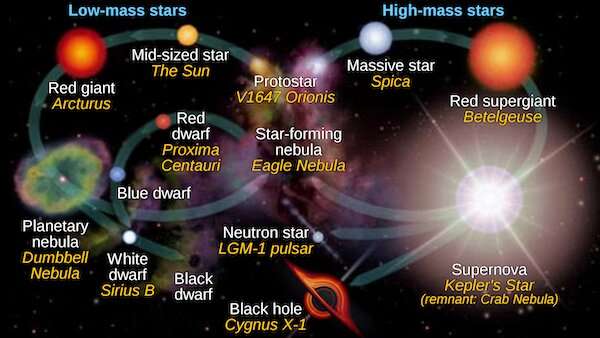New research on Supernovas shows stars emit early signs of the end before their eventual celestial death, allowing researchers to gather more data on the lifecycle of stars.

An early predictive system has been developed by astronomers from Liverpool John Moores University and the University of Montpellier to alert when a major star is ready to end its life in a supernova explosion. The paper, (Ben Davies et al, Explosion Imminent: the Appearance of Red Supergiants at the Point of Core-Collapse) published in the Monthly Notices of the Royal Astronomical Society, discusses how large stars (between 8-20 solar masses), in the final stages of their life cycle, in their “red supergiant phase”, abruptly becomes a hundred times fainter in visible light in the months leading up to its death.
The development of a buildup of circumstellar matter or debris surrounding the star is found to be the source that dims the star’s lustre. While previous research had no records on how long the stars required to accumulate this encasement of debris, this discovery has led scientists to simulate how red supergiants would appear as they begin to die. Archival test images of stars impending to explode within a year show that the rate of acceleration of the buildup was rapid, and was built in less than a year.
Stars begin their life in a variety of ways; some begin small and grow to become larger through time, while others are large from birth. Some stars fade away and some others burn out in a massive cataclysmic explosion. Once the star reaches the ‘red supergiant’ phase, it does not take long for the star becomes massive enough for the cores to produce iron and lose their ability to support nuclear fusion, and lose mass through ejections that occur as the star ages.
Lead author of the paper, Liverpool John Moores University’s Benjamin Davies says that the material that surrounds the star “completely obscures it (the star)” which would “making it 100 times fainter in the visible part of the spectrum”, suggesting that the star would disappear, if not completely, the day before the star collapses. Previously, Supernova events could only be observed after they had occurred. Davies urges that with this early-warning system scientists can now observe this phenomenon and use the world’s best telescope to watch the stars as they live out their last moments, observable instantaneously from Earth.

The star Betelgeuse, a red supergiant in the Orion constellation, made headlines earlier in August for being the superstar that gave the world a glimpse into a star’s end, dying before our eyes in real-time. The celestial “dimming” helped to fill gaps that earlier research could not piece together, such as the drastic acceleration of Betelgeuse’s pulsation rate after it, quite literally, blew its top in 2019, through a massive surface mass ejection (SME) that occurs when a star ejaculates large amounts of plasma and magnetic flux into its atmosphere. This surface injury is one of the most fascinating concepts that scientists are currently researching.
However far and wide we observe into our universe, the stars that illuminate our night sky will always remain in the past, due to limitations caused by the speed of light.
Read more:Life on Mars! Conked due to Climate change













